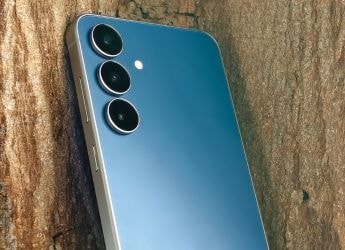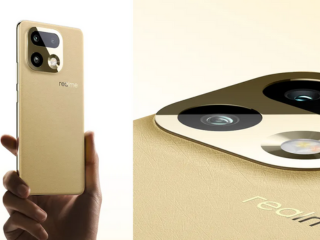- Home
- Laptops
- Laptops Features
- Diversifying, Manufacturing, and Marketing CPUs for the Angstrom Era: Intel's Next Five Years
Diversifying, Manufacturing, and Marketing CPUs for the Angstrom Era: Intel's Next Five Years
With a new CEO at the helm, Intel is pushing forward with next-gen manufacturing capabilities and some fresh branding.

Left: Intel RibbonFET transistor structure representation; Right: Dheemanth Nagaraj, Intel Fellow
Intel recently made a number of major announcements about its future product roadmaps, manufacturing technology, and marketing strategy. Not only will it open up its fab and foundry capabilities to third parties, but Qualcomm and Amazon's AWS have already signed on as clients. We've often used terminology like 14nm and 10nm to describe how transistors need to get smaller over time to allow for greater density and efficiency, but Intel is now switching to catchy branding – Intel 7, Intel 4, and Intel 3, in succession. Beyond 2024, Intel 20A and 18A will mark the “Angstrom era”, introducing new kind of transistor called RibbonFETs promising greater efficiency at microscopic scale.
Offering foundry services to competitors is a big pivot, and it isn't common to have a roadmap laid out five years in advance. This is a show of strength for a company that has had to fight its way out of some massive setbacks due to repeated delays with its 10nm and 7nm transitions, plus a cancelled 5G smartphone modem business effort, leading to cascading effects for several years now. On top of all that, rival AMD has been delivering solid high-performance CPUs, Apple is migrating to its own in-house silicon, and smartphones continue to grow more powerful.
On the bright side, the chip giant has a new CEO, the global pandemic has accelerated demand for PCs, high-profile manufacturing partnerships have been announced, multiple advancements are set to hit the market soon, and several other focus areas such as graphics, AI and supercomputing are poised for serious growth.
We had a few questions after Intel's slew of announcements, particularly with regard to how the future of consumer desktop and laptop PCs will unfold. As the company prepares for the launch of its 12th Gen ‘Alder Lake' Core CPU family, we were able to get some answers from Dheemanth Nagaraj, who has worked with Intel's architecture, graphics and software engineering at the Intel India Design Centre, and is the first Intel Fellow from India.
![]()
A representation of Intel's transistor type and process node changes
Gadgets 360: “Superfin” branding was introduced only a year ago and is now being dropped. Why does Intel feel the need to shift the perception of its process tech?
Nagaraj: We are already in high-volume production with the 10nm SuperFin node that we introduced last year, with the largest single, intranode enhancement in Intel's history. This name will not change. Based on performance and power projections, our next node – which we previously called Enhanced SuperFin – now becomes Intel 7. Intel 7 will be followed by Intel 4 and Intel 3. After Intel 3, the next node will be called Intel 20A. We're refreshing our lexicon to create a clear, consistent, and meaningful framework to help the industry and our customers, including our foundry customers, make better-informed decisions.
Gadgets 360: Does the average consumer care about manufacturing process tech? Considering that Intel's 14nm CPUs have been competitive for so long, why even emphasise this number?
Nagaraj: We've said in the past that end users don't buy process, they buy products. We still believe this to be true. The success and positive reviews of our Tiger Lake CPU built on 10nm SuperFin against competing products is a great example. The reason for [the Intel Accelerated announcements] was to share one of the most detailed process and packaging roadmaps we have ever provided to give customers the confidence that they can expect a predictable cadence of leadership products and foundry services for them.
Gadgets 360: Will ‘Intel 7', ‘Intel 20A' etc become mainstream marketing points? What exactly do the numbers 7, 4 and 3 represent? Why not call them 70A, 40A, 30A and then progress to 20A instead of introducing a transition there?
Nagaraj: Our node naming is based on key technical parameters that matter to our customers, including process performance, power, and area, and is based on a holistic assessment of improvement across these factors. For example, we're expecting an approximately 10-15 percent performance per Watt increase with Intel 7 as we evolve the node – equivalent to a full node of performance gain. In addition, Intel 7 is comparable with similar external foundry nodes.
When we look at power performance and density, Intel 4 has more than a full node's worth of improvements compared to Intel 7. Intel 4 is expected to deliver an approximately 20 percent transistor process performance per Watt increase. Our analysis also indicates that Intel 4 is expected to be comparable to the industry at the same node.
Intel 3 will continue to reap the benefits of FinFET and will deliver an approximately 18 percent transistor performance improvement per Watt compared to Intel 4, and improvements in power and area according to early modeling and test chip data. This higher than a standard full node improvement for Intel – or indeed for other vendors.
Intel 20A is meant to mark the start of the Angstrom era of semiconductors, in which we are crafting devices and materials at the atomic level. With this node, we transition to two groundbreaking technologies; an entirely new transistor architecture named RibbonFET, and a first-of-its-kind innovation called PowerVia to improve power delivery. Like all nodes since 1997, Intel 20A does not represent any single physical process feature.
![]()
Intel CEO Pat Gelsinger speaks during the Intel Accelerated virtual event
Gadgets 360: How is Intel 7 different from Enhanced Superfin – is it a renaming or replacement?
Nagaraj: Enhanced SuperFin is now Intel 7. It follows 10nm SuperFin later in 2021 and will deliver approximately 10 to 15 percent transistor performance per Watt improvement as we evolve the node. Alder Lake and Sapphire Rapids will be based on Intel 7.
Gadgets 360: If Meteor Lake is taping in Q2 2021, what is the timeline for consumer launches of Raptor Lake and Meteor Lake? Is this still the expected progression or has the roadmap changed?
Nagaraj: Meteor Lake will feature Intel 4 and start shipping in 2023.
Gadgets 360: How big of a change is the introduction of RibbonFET? How drastically will CPUs change in terms of size, power, packaging, core and iGPU configurations, target deployments, etc?
Nagaraj: We will introduce Gate All Around (GAA) transistors with Intel 20A, our first new transistor architecture since we pioneered FinFETs in 2011. GAA has been in development across the industry for several years, and the name comes from a transistor architecture in which the gate is wrapped around the channel. Intel calls our version of GAA RibbonFET. We expect that the first product for RibbonFET will be a leadership client solution. Overall, we expect broad range of Intel and Industry products on Intel20A.
Our process roadmap is tuned for high-performance applications. The GAA “nanoribbons” in our RibbonFET technology enable higher drive current at all voltages, which will translate to a significant performance boost for our products. Just as we did with FinFET technology, we will continue to enhance RibbonFET technology in subsequent generations. Intel 18A is already in development for early 2025 with refinements to RibbonFET that will deliver another major jump in transistor performance along with clear process performance per Watt leadership.
Gadgets 360: Will developments like Foveros and PowerVia become standard for mainstream consumer-grade CPUs?
Nagaraj: Meteor Lake will be the second-generation implementation of Foveros in a client product. We also expect the first product for PowerVia to be a leadership client solution. In addition, these technologies will be available to Intel Foundry Services (IFS) customers.
Gadgets 360: Where do you see the consumer PC market in 2025? What kind of use cases, form factors, and experiences will this new roadmap lead to?
Nagaraj: The PC has withstood the test of time and continues to thrive when it comes to innovation. We are relentless in our path to innovate with the magic of silicon. As we have shown in our roadmap, we have a clear path to enter the Angstrom era. These products will fuel the continued digitization of everything and create world-changing technology that improves the lives of every person on earth.
![]()
Intel also announced new manufacturing techniques that will allow for increased density and power efficiency
Gadgets 360: Will 20A eventually serve the entire consumer PC market or will there be segmentation in terms of different processes and packaging tech being suitable or cost effective for different segments?
Nagaraj: Overall, we expect a broad range of Intel and industry products on Intel 20A. For example, Qualcomm was part of our Accelerated event highlighting the opportunity to partner on 20A.
Gadgets 360: When will we start seeing Intel deliver the first chips that are manufactured for foundry clients?
Nagaraj: At Intel Accelerated we have announced two customers for IFS. We have signed AWS as our first customer to use IFS packaging solutions. We are also excited about the opportunity to partner with Qualcomm using our Intel 20A process technology. Both Intel and Qualcomm believe strongly in the advanced development of mobile compute platforms and ushering in a new era in semiconductors. Stay tuned for more updates from IFS.
Gadgets 360: What is Intel's strategy to sign on foundry clients who have so far used TSMC, Samsung, GlobalFoundries etc?
Nagaraj: As we announced at our Intel Accelerated event, we expect to deliver an annual cadence of new process technology capabilities and we are on a path to achieve process performance per Watt leadership. We're also excited by the enthusiasm for IFS we are seeing in the industry, as underscored by the two customers we have announced.
That said, competitiveness is about much more than just process technology. We will differentiate ourselves from other foundry offerings with our combination of leading-edge 3D packaging and process technology, committed capacity in the U.S. and in Europe – available for customers globally – and a world-class IP portfolio, including x86 cores as well as ARM and RISC-V ecosystem IPs.
We will also provide access to silicon design services to help our customers seamlessly turn silicon into solutions, using industry-standard design packages. Having highly technical and discerning customers such as AWS and Qualcomm now committing to IFS is a strong testament of broad interest and progress.
Gadgets 360: Will Intel continue to use third-party fabs for its own chips while simultaneously fabbing chips for outside clients?
Nagaraj: Intel's focus is to deliver leadership products to customers regardless of where different tiles might be manufactured. We will continue to build the majority of our products in Intel fabs. We will also expand the use of third-party foundry capacity to provide our product teams with the richest set of process options, assuring the best products in every category we compete. We will optimise our roadmaps for cost, performance, schedule, and supply.
Gadgets 360: Will the entire portfolio of process and packaging tech be available to clients while Intel uses them for its own products?
Nagaraj: With exploding demand for silicon across a swath of applications, all of the new innovations discussed at Intel Accelerated will also be available to our Intel Foundry Services customers, including Intel 3, Intel 20A, and Intel 18A, as well as Foveros Direct and Foveros Omni. One of the strengths of IFS is that we offer both leading-edge process and packaging innovations as well as modernized access to our historical technologies. For example, IFS is also offering Intel 16, an enhanced version of the technology previously referred to as 22FFL. We are already engaging with foundry customers on this technology, which provides a compelling combination of performance, power, density, and ease of design for a variety of low-power and high-performance applications.
![]()
Intel 'Meteor Lake' test package, fabricated using Foveros tech, shown off during Intel Accelerated
Gadgets 360: Will taking on foundry clients be a major push to establish (or take over) new fabs and foundries?
Nagaraj: We have already announced the expansion of our advanced chip manufacturing capacity by investing $20 billion in two factories in Arizona. We plan to open these new factories to outside customers. Additionally, we plan to expand our presence in the U.S. and in Europe to ensure a sustainable and secure semiconductor supply chain for the world.
Gadgets 360: Is there any scope for establishing any part of the CPU production process in India?
Nagaraj: For now, Intel's manufacturing requirements will continue to be met by our facilities around the world. In India, Bengaluru remains home to Intel's second-largest design centre globally.
Gadgets 360: Has Intel sorted out the manufacturing capacity issues that led to severe shortages and price instability of CPUs over the past few years?
Nagaraj: Global demand for semiconductors continues to accelerate, and demand for Intel products continues to be very strong. We've been expanding our capacity to meet this demand and, as a result, we expect to grow our total annual client CPU supply double-digits year-over-year versus 2020. However, the unprecedented global demand for semiconductor components has led to an industry-wide shortage of critical third-party components, which is impacting technology providers across the industry. We expect this to last for 1-2 years.
Leveraging our IDM advantage, we're working aggressively across our global supply chain to solve substrate and other component shortages to satisfy our customers' surging demand and gain market share.
Gadgets 360: How is Intel responding to the current global semiconductor shortage, and is it getting better or worse?
Nagaraj: The supply constraints facing the industry today demonstrate why it's critical to invest in capacity ahead of demand. We are building Intel's first large-scale foundry operation, which includes two new fabs in Arizona, located in Intel's Ocotillo campus, with planning and construction activities having already commenced. We have also announced additional investments, including $3.5 billion to expand our New Mexico facility to support manufacturing of our advanced packaging technology.
Get your daily dose of tech news, reviews, and insights, in under 80 characters on Gadgets 360 Turbo. Connect with fellow tech lovers on our Forum. Follow us on X, Facebook, WhatsApp, Threads and Google News for instant updates. Catch all the action on our YouTube channel.
Related Stories
- Samsung Galaxy Unpacked 2025
- ChatGPT
- Redmi Note 14 Pro+
- iPhone 16
- Apple Vision Pro
- Oneplus 12
- OnePlus Nord CE 3 Lite 5G
- iPhone 13
- Xiaomi 14 Pro
- Oppo Find N3
- Tecno Spark Go (2023)
- Realme V30
- Best Phones Under 25000
- Samsung Galaxy S24 Series
- Cryptocurrency
- iQoo 12
- Samsung Galaxy S24 Ultra
- Giottus
- Samsung Galaxy Z Flip 5
- Apple 'Scary Fast'
- Housefull 5
- GoPro Hero 12 Black Review
- Invincible Season 2
- JioGlass
- HD Ready TV
- Laptop Under 50000
- Smartwatch Under 10000
- Latest Mobile Phones
- Compare Phones
- Huawei Nova 15
- Huawei Nova 15 Pro
- Huawei Nova 15 Ultra
- OnePlus 15R
- Realme Narzo 90x 5G
- Realme Narzo 90 5G
- Vivo S50 Pro Mini
- Vivo S50
- Asus ProArt P16
- MacBook Pro 14-inch (M5, 2025)
- Huawei MatePad 11.5 (2026)
- OnePlus Pad Go 2 (5G)
- Huawei Watch 10th Anniversary Edition
- OnePlus Watch Lite
- Acerpure Nitro Z Series 100-inch QLED TV
- Samsung 43 Inch LED Ultra HD (4K) Smart TV (UA43UE81AFULXL)
- Asus ROG Ally
- Nintendo Switch Lite
- Haier 1.6 Ton 5 Star Inverter Split AC (HSU19G-MZAID5BN-INV)
- Haier 1.6 Ton 5 Star Inverter Split AC (HSU19G-MZAIM5BN-INV)
















